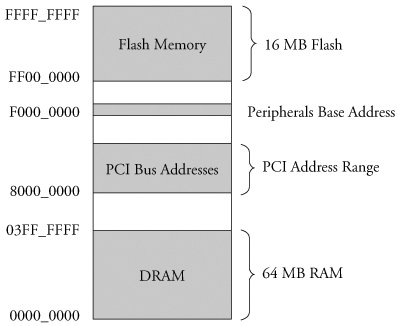Книга: Embedded Linux Primer: A Practical, Real-World Approach
2.3.5. Memory Space
2.3.5. Memory Space
Virtually all legacy embedded operating systems view and manage system memory as a single large, flat address space. That is, a microprocessor's address space exists from 0 to the top of its physical address range. For example, if a microprocessor had 24 physical address lines, its top of memory would be 16MB. Therefore, its hexadecimal address would range from 0x00000000 to 0x00ffffff. Hardware designs commonly place DRAM starting at the bottom of the range, and Flash memory from the top down. Unused address ranges between the top of DRAM and bottom of FLASH would be allocated for addressing of various peripheral chips on the board. This design approach is often dictated by the choice of microprocessor. Figure 2-5 is an example of a typical memory layout for a simple embedded system.
Figure 2-5. Typical embedded system memory map

In traditional embedded systems based on legacy operating systems, the OS and all the tasks[10] had equal access rights to all resources in the system. A bug in one process could wipe out memory contents anywhere in the system, whether it belonged to itself, the OS, another task, or even a hardware register somewhere in the address space. Although this approach had simplicity as its most valuable characteristic, it led to bugs that could be difficult to diagnose.
High-performance microprocessors contain complex hardware engines called Memory Management Units (MMUs) whose purpose is to enable an operating system to exercise a high degree of management and control over its address space and the address space it allocates to processes. This control comes in two primary forms: access rights and memory translation. Access rights allow an operating system to assign specific memory-access privileges to specific tasks. Memory translation allows an operating system to virtualize its address space, which has many benefits.
The Linux kernel takes advantage of these hardware MMUs to create a virtual memory operating system. One of the biggest benefits of virtual memory is that it can make more efficient use of physical memory by presenting the appearance that the system has more memory than is physically present. The other benefit is that the kernel can enforce access rights to each range of system memory that it allocates to a task or process, to prevent one process from errantly accessing memory or other resources that belong to another process or to the kernel itself.
Let's look at some details of how this works. A tutorial on the complexities of virtual memory systems is beyond the scope of this book.[11] Instead, we examine the ramifications of a virtual memory system as it appears to an embedded systems developer.
- Kernel Address Space
- 12.2.1 Port-Mapped vs. Memory-Mapped I
- 2.3.7. Process Virtual Memory
- 2.1.1 Program Memory Organization
- EVENT MEMORY SIZE
- Using Double Quotes to Resolve Variables in Strings with Embedded Spaces
- namespace-uri()
- Chapter 2. Four Puzzles From Cyberspace
- Displaying Free and Used Memory with free
- 2.3.1. Flash Memory
- 6.2.1. First User Space Program
- 9.3. MEMORY MANAGEMENT IN CHORUS




